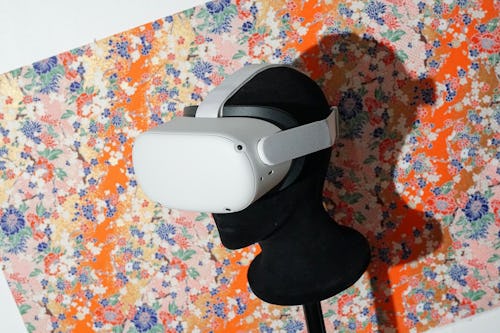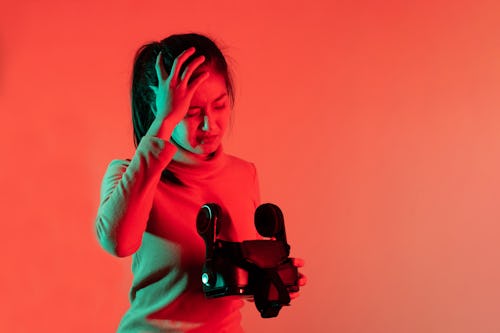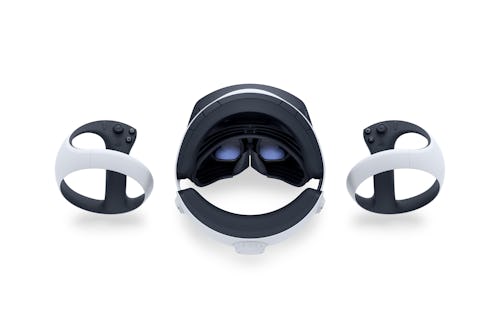
The day I found out I had severe video game-induced motion sickness is branded in my brain.
I was 10 years old and at my godmother’s house for Shabbat watching her son and friends play Call of Duty: Modern Warfare 2. The sofa was crowded so I was sitting up close to the CRT TV, watching them play surprisingly well for pre-teens; they explained to me that they didn’t really care about the story mode, only the multiplayer. I had a Wii at home from the prior Hanukkah and only cared for playing Super Smash Bros: Brawl.
All was going well for an hour or so until suddenly I started to feel extremely hot and disoriented. I removed myself from the room and was basically out of commission for the rest of the evening. I felt like I’d been poisoned.
This is a problem that persisted and, eventually, I accepted was a key part of how I choose which games to buy when multiple attempts to try other first-person games like Skyrim ended in failure to sustain play for me. With one exception (more on that later) I just avoid first-person games altogether.
Despite knowing it would probably be unplayable for me, I picked up a PS VR in 2016 to give it a shot. Even games that didn’t require intense motion, like the pack-in title Playstation VR Worlds, were a no-go for me. The headset wasn’t responsive enough and the image and screen quality led to eye strain. By the time I took the PS VR off my head, I was sweaty and ready for a nap to recover.
While there have been a lot of improvements to VR hardware in the years since, the technology still lags far behind its greatest ambitions, even as some of the world’s most powerful people seem set on making a VR/metaverse future a reality. For people like me who can barely stay in a headset for more than a few minutes, this messaging is somewhat maddening.
If VR and the metaverse are the future, there’s a lot more work needed to get people like me on board.
A generation on the way out
I think of the VR headsets that came out in the 2010s as VR’s first generation, ending with the Oculus (er...Meta) Quest 2. PS VR, the Valve Index, HTC Vive, and every Oculus product all shared the same limitations and features in one way or another; the Quest 2 managed to encapsulate most of what made those headsets great in one product that works wirelessly and acts as a PC headset for those with a powerful enough gaming rig. As impressive as that first generation was, I never felt like attempts were being made to address severe motion sickness. The focus was dead set on making "consumer VR" viable and generally accessible — the Quest 2 has been the ultimate version of that dream.

I’ve spent good time using friends’ Quest 2’s and while the headset’s higher refresh rates are certainly an improvement over the PS VR, ultimately the optics and display quality are what do me in. I’m just sensitive enough to be thrown off by the tiniest bit of lens distortion and blur. My friends who own the headsets always have nothing but great things to say, and can normally keep the headsets on as long as they want.
The biggest advancement the Quest 2 had for me was reducing my overall discomfort. While I can only play games on the Quest 2 for 10 minutes or so, I get nowhere near as hot and need less time to recover from play sessions. Seeing these pain points addressed so quickly was encouraging even though I’ve never had an experience with the Quest 2 positive enough to buy my own.
What’s the problem?
Motion sickness in gaming is a surprisingly complicated issue, and the root causes of it have yet to be pinned down definitively; developers have been trying to solve it for years regardless. What research we do have suggests that gaming and VR-induced motion sickness, or “simulation sickness” are caused by a conflict between your different senses. When we move, fluid in our ears helps us maintain balance while our eyes provide data on where we’re going. For some people, these two bodily functions conflicting leads to motion sickness. This is why many like myself can’t read in a car. Your eyes are essentially providing information to your brain that you’re staying still while your ear fluid is telling a totally different story.
There’s also the sense of “proprioception” that first-person games can cause conflict with. During fast-moving sequences especially, seeing your character’s own hands and feet in action from a first-person perspective can be especially jarring. I lasted only a few minutes into the experimental action movie Hardcore Henry because of this phenomena, and fast-paced first-person games are no different.

Research on relief of symptoms is even more limited and I have been unable to find anything conclusive as a “silver bullet” for motion sickness. Forum and Reddit threads are littered with anecdotal advice for a variety of remedies. The most common ones I’ve found range from chewing gum, which supposedly moves the fluid in your ears enough to alleviate sensory conflict, to brightening the room and sitting farther away from the screen to reduce the motion information your eyes send in the first place. Other players swear by consuming ginger in various forms or just setting up a fan to keep cool air flowing over your face. I’ve tried out some of these solutions to aid with third-person games with poorly implemented cameras to mixed results, but if they work for other peoples’ motion sickness, more power to them.
Uncertain solutions
VR presents a whole host of issues for players relying on these anecdotal remedies. VR obviously takes up your entire FOV with displays very close to your face. The only thing close to conclusive I could find is an old 2000 study suggesting that adaptation to simulation sickness is possible with time and increased exposure. Of course, if playing a game makes you violently ill, it’s not advisable to wean yourself onto it. “Time makes it better” is only advice I would offer to people who get mildly dizzy from VR or games.
Motion sickness in gaming is a surprisingly complicated issue.
In the case of VR, even if motion sickness can’t be eliminated completely, steps should be taken to prolong the effect of motion sickness in affected users as long as possible. This means taking steps at the hardware level to increase refresh rates and the response of movements could make VR use possible for many more players. Perceptible lag in the picture while I’m moving my head is the biggest thing that prevents me from using VR for extended periods, as I become too uncomfortable too quickly for my body to properly adapt. If future headsets improve refresh rates enough to enable me to at least have a few comfortable but short play sessions over time as I adjust to a game, it’s theoretically possible I can overcome motion sickness on a game-by-game basis.
Increases to the quality of optics is also going to be key. Lens distortion combined with lower-quality screens make current VR headsets disorienting from the jump to some. While the goal of headsets acting as a perfect window into a virtual world is a lofty one, headsets striving to get closer to that experience can only help relieve eye strain.
The addition of stable and persistent on-screen elements in more games like a reticle, or an accessibility setting to enable them, would also go a long way to make VR games playable as well. Reticles provide a place for you to anchor your vision during gameplay and, in my experience, help me play games I thought I wouldn’t be able to.
Dogfighting game Star Wars Squadrons, which I have just under 100 hours logged in, is to this day the only first-person game I can play for extended sessions. The game has a very wide field of view and a camera that doesn’t move too dramatically when you’re turning your ship. This is even the case with the most nimble ships in the game. The game is superbly optimized as well, rarely dipping below 60 fps on PS5, making it a joy to play for me. It also has a very prominent reticle for me to focus on during gameplay and is designed around keeping as much of the action in the center of your field of view as possible.
Squadrons showed me that there is hope to use VR one day in my future if headset tech catches up to take advantage of the powerful consoles now at our disposal. I doubt I’ll be able to play every VR game that comes out, but I do think that proper game design with the right headset will open some doors to people like me. So, as the second generation of VR is upon us, I’m wondering if the day I can confidently buy a VR headset is around the corner or still years away.
A promising next generation
The best-designed VR game out there will be nothing without an equally capable computer and headset to run it. Future headsets need to hyper focus on comfort, display quality, and optical distortion. These are unlikely to entirely eliminate motion sickness but they will make it easier for players to adjust over time, whereas current headsets cause such an intense level of discomfort in some that constitutions fail before they can compensate. If any headset’s optics are fine-tuned enough that I quickly forget that I’m looking at a distorted screen through thick glass, it would be a complete game-changer for players like me. Higher refresh rates and lower response times would just be icing on the cake. I’m sure high-quality lenses like this will be reserved for the highest-end of headsets to start, but any breakthrough is worth celebrating.
That being said, there are some upcoming VR headset announcements that have me hopeful.
Sony's second-gen PS VR2 seems like the most likely candidate for me to get some hour-long play sessions out of. The headset uses 4K OLED displays for much higher picture quality, with refresh rates targeting 90-120Hz. It will also improve motion tracking thanks to proper inside-out tracking with cameras on the headset. The most exciting feature to me is the ventilation system. Yujin Morisawa, Senior Art Director at SIE and lead headset designer for PS VR2, says it’s designed to allow airflow through the headset “similar to the vents on the PS5 console that allows airflow.” While Sony does not clarify whether this is active cooling or just better-designed passive ventilation, it’s promising that Sony is considering airflow more after the facial furnace that was the original PS VR.

Apple is the forthcoming player that I’m most interested in. If rumors are to be believed, the company’s “mixed reality” headset might be announced this year. (Maybe at WWDC in June?) Most rumors claim the headset could use dual 4K displays and also feature inside-out tracking. What’s unclear is if it will offer any pure VR applications or Apple will focus on augmented reality entirely. Apple CEO Tim Cook has repeatedly said that VR is an isolating technology and has suggested AR is "profound."
"I like our products amplifying thoughts and I think AR can help amplify the human connection," Cook told the BBC in 2017. "I've never been a fan of VR like that because I think it does the opposite."
Apple is a company that endeavors not to launch something until it’s ready, so I can only hope that accounting for severe motion sickness is a major qualification for readiness. Even if the Apple headset is too expensive for me, if it solves a lot of the pain points of current headsets it could be a huge driver of innovation from competitors.
Meta’s future headset plans have been teased but concrete details are lacking. While we don’t know much about a direct successor to the entry-level Quest 2, “Project Cambria” is also supposed to launch this year as Meta’s new high-end headset to sit above the Quest 2. All we know so far is that Cambria will include loads of new sensors to make VR more immersive, enable mixed-reality applications, and have improved optics over older headsets for better visual fidelity.
To Meta’s credit, they’re also hinting at in-house solutions to motion sickness relief. While no specifics have been shared yet, Consulting CTO at Meta John Carmack, has talked about making a future VR system more depth aware at a system level and allowing games to render environments using that hardware-level awareness. “What we need to do is look at the depth of things relative to your view, how much it’s moving incorrectly relative to the inertial stuff and only fade out things proportional to that relationship.”
An accessible path forward
If you go back through this essay, most of the language I’m using is highly speculative because it’s mostly all I have to go on. Some specs and features for upcoming headsets seem like they might be better for my motion sickness, but I have no real way of knowing. Better optics and refresh rates will make VR more comfortable for all by proxy, but if companies are serious about making VR a mainstream application for gaming and work, they need to be more proactive to address all who can’t currently use it.
It would greatly improve my own confidence if Mark Zuckerberg or Sony's Mark Cerny, who is the lead architect for PlayStation devices including the PS5 got on stage and laid out features to address motion sickness in their new products because at least I’d know they’re trying to solve the problem. All I’m asking for is some reassurance that I can buy a headset and spend an hour or two using it without feeling like my whole day is ruined afterward.
A great starting point would be a list of universal accessibility guidelines and APIs for developers to adopt for motion sickness and any other limitations players face in using VR. VR presents a wider issue for accessibility in games and requires completely different inputs compared to traditional games. While lots of progress has been made in traditional gaming (with more work to come), VR is basically a new frontier from the perspective of accessibility advocates. The Able Gamers Foundation has long advocated for a universal set of guidelines and language to help redefine how we think of accessibility, and this mindset is exactly what VR companies should take when designing VR software and hardware.
It’s hard to be told the future is something you can’t feasibly access yourself today.
Wired spoke to many disability advocates earlier this month about this exact issue. For players with inhibited or limited motor functions, for instance, a common complaint of current VR hardware is that they require too much total body movement, with no option to toggle that off. Other players struggle with the fine degree of finger and hand inputs so many games call for. Most current headsets offer no way for these players to accommodate their specific needs.
As Erin “geekygimp” Hawley told Wired: “The need to use both controllers and to reach objects that are high up locks me out of most apps and games.” Adding system-level support for more accessible controllers, and allowing alternative ways to input motion controls would finally open the door to players eager to use VR.
In the case of aiding motion sick players, headsets should include a universal reticle API that players can choose to toggle on, with developers working to make it more responsive in context to each game. Allowing players to set a preferred field of view and motion blur strength setting that’s applied across games would also be helpful. Most importantly, as research on motion sickness improves, VR platforms need to stay ahead of the curve on developing software features to address newly found remedies. This is why Carmack’s idea of letting the headset play a greater role in aiding apps to reduce motion sickness is so promising. The more work the headset is doing, the greater ability developers have to reach a wider audience if those solutions pan out. For something as complex as motion sickness, it’s an enormous burden to expect each developer to solve it alone.
It’s hard to be told the future is something you can’t feasibly access yourself today. Whether the metaverse pans out to encompass all our lives, or if VR just becomes another cool way to game, I don’t want to be left behind. While things seem like they’re getting better, it’s time for companies to take a more proactive step to make VR open for all. My motion sickness is just one issue that is keeping me out of the metaverse for now, but there are so many players with completely different needs at risk of being left on the sidelines too.
VR Week 2022 is an in-depth look at the decades-long future of VR successes, failures, and innovations to come.
More VR Week 2022 stories:
- How one group is remaking sign language for the VR age
- Hot job alert: metaverse architect
- The 9 best apps to get started working in VR
- Inside the volunteer 'police department' arresting people in VR
- There’s no VR internet in our future — at least not one we’d want
- The 11 best hardcore VR games you should play right now
- From ‘The Lawnmower Man’ to Meta: VR’s most important moments







